With the recent advancement in printing technologies, it is quite hard for a Forensic Document Examiner (FDE) to depict whether the document is originally printed or a copy.
For analysis, a private FDE can charge you between $200 to $400. But, the best part is that if you scan your eyes over the printed and photocopied documents, you will get clues that lead you towards their originality.
Still, of course, you need a certified FDE, to testify in court about the authenticity of those questioned documents.
So, this post is for curious, forensic students, and QD examiners who want to get a relevant perspective on how to differentiate between printed and copied.
Table: Photocopied Documents Vs Printed Documents
| Features | Photocopied Documents | Printed Documents |
|---|---|---|
| Individualization | Easier than printed documents | Difficult than photocopied |
| Clarity than Original | No | All have the same clarity |
| Saturation and Contrast | Less/more contrast than original | Same contrast |
| Finer Details | Fine details possibly missing | Possibly present |
| Dimension Distortion | Not same (1% to 2% difference) | Same dimensions |
| Multiple Successive Copies | Contrast becomes fainter with each copy | Same contrast among all copies |
| Signature or Written text | Less contrast and pen detailing, even e-signed | Detailed pen features |
| Physical Alteration (pasting signature, text) | Possible, like pasting a signature | Not possible (unless alteration in e-docs) |
| Physical Defect Marks (staples, holes) | May be present | Absent, if not in e-doc. |
| Transitory Defects Marks (easily cleaned) | May present | Absent |
| Glass platen Marks | May present | Absent |
| Backing Blanket Marks | May present | Absent |
| Imaging Lens Defects | May present | Absent |
How to Differentiate Between Photocopied and Printed Documents?
Note: The following differences are mostly taken into consideration when the e-documents are generated directly from word pressing software rather than the scanned copy of the documents. If the print is generated from scanned copy, it becomes more difficult to differentiate between printed or photocopied documents.
1. Individualization of Machine
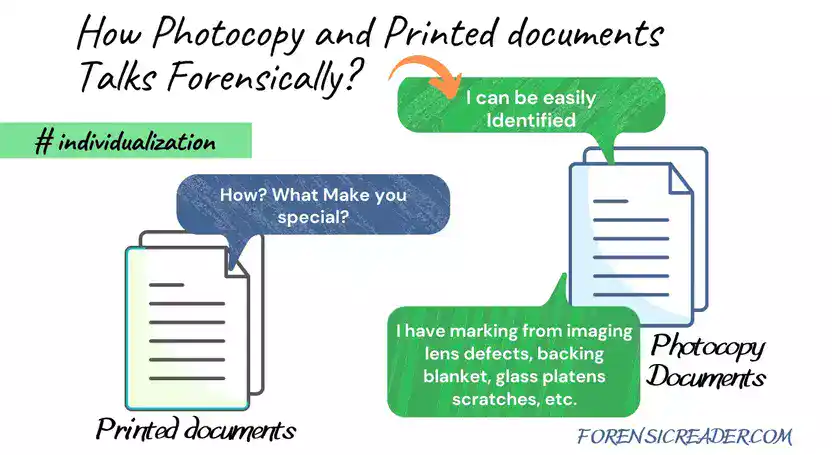
In printed documents, there are fewer mechanical parts involved in printed docs than in photocopied ones. This leads to a lesser possibility of individualizing a printer.
But with a close examination, an FDE can determine which printer technology is used to print that document.
In the case of photocopy, there are various additional measures such as imaging lens defects, backing blanket marks, glass scratches, etc. that lead to more possible findings.
Bottom line: Individualization of printers from printed documents requires extra effort than a xerox/photocopier.
2. Clarity than Original
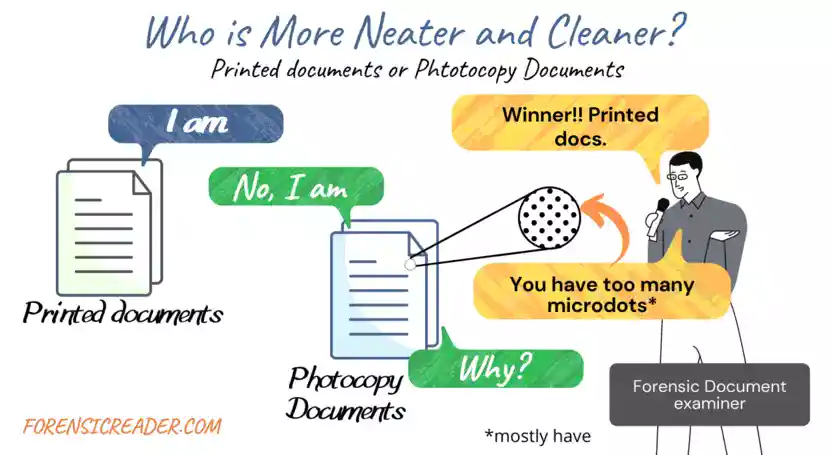
A copied document can’t be as clear as the original document from which it is copied. This is due to the fact that copying requires additional mechanical parts such as
- Mechanical handling of original documents
- Imaging lens defects
- Glass platen scratches and debris
- Etc…
This is the reason why photocopying is not a perfect process that eventually leads to minor differences between copies.
Bottom line: A copied document will never be as clear as the original (microscopic changes are there), but printed documents share the same clarity as the original e-document.
3. Saturation and Contrast
Saturation is broadly used in color operation while for mono-color printing, contrast is used as a comparison metric.
Contrast: Photocopies, in general, can print a fainter contrast reproduction at normal contrast settings. As a result, finer details such as written text or signature spurs are not precisely replicated on the copy.
However, if settings are brought to darker, then it produces a darker replication. In both cases, the contrast differs from that of original printed documents.
Saturation: Conversely, it is very difficult to depict the faintness in mono-color documents but can easily be seen in color-copied documents. This is due to the inability of photocopies imaging lenses to capture exact color details from original printed documents.
Here is the image of a printed and photocopied color document.
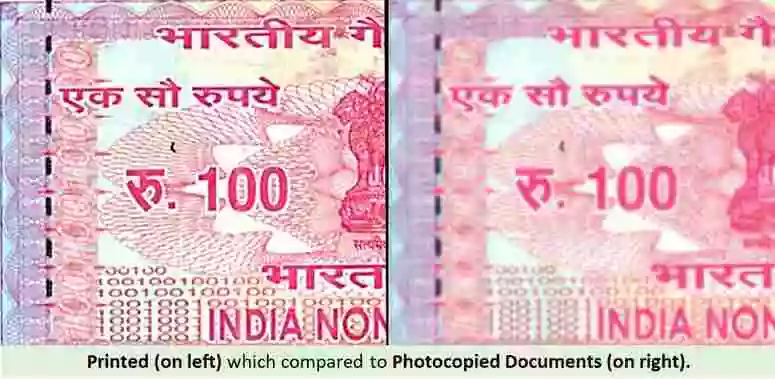
Bottom line: The photocopied documents have different—lighter or darker— contrast and saturation than the original printed documents.
4. Fineness and Detailings

It is also a metric that can easily help an FDE to differentiate between a printed and photocopied document.
Generally, the magnification power and ability to capture minor details are governed by the imaging lens of photocopiers and their ability to replicate it.
But most office printers fail to do so.
In those cases, the following characters are seen in photocopied documents w.r.t. fineness and detailing:
- Noise and small dots in the text region.
- Contour roughness on the characters.
- Missing glossiness in authentic glowing stamps.
- Smudged micro details.
The amount of noise and surround dots depends upon the originally printed technology types.
For instance, higher noise or micro-dots are seen if the original document is printed with dot-matrix followed by inkjet. And laser-printed original documents have the lowest noise/microdots.
Note: With the increased quality of modern photocopies, the scanning and replicating power in terms of fineness is quite good. Hence, FDE should thoroughly inspect them.
5. Dimension Distortion
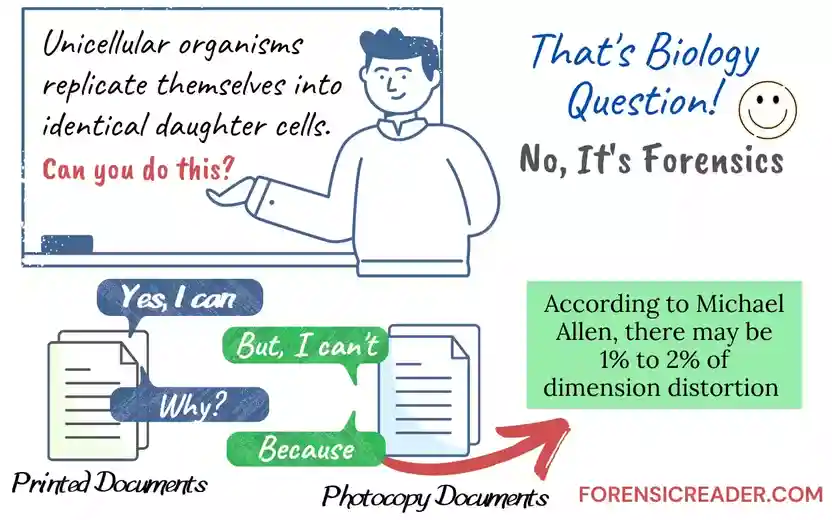
In most cases, photocopiers cannot reproduce the exact 1:1 dimension. It is visible and noticeable when successive copies of copied documents are made.
According to Michael Allen’s book, there may be 1% to 2% of dimension distortion seen, which can either be in one direction or in both directions (across and down).
Unlike photocopiers, modern computer printers produce identical prints without resizing them.
Bottom line: Photocopier produces copies with 1 to 2% of dimension distortion. Printers, on the other hand, can produce a large number of identical prints without changing the aspect ratio.
6. Multiple Successive Copies
With each successive copy, there are more and more additions of the individual characteristics and dimension distortions.
For instance, the first photocopy document loses some minor detailing and faintness. In the subsequent second copy, you might see more smudged detailings. With the fourth and fifth copies, most of the fine detailing gets missing with a considerable dimension distortion.
On the other hand, all the printed pages have the same contrast and detailing irrespective of their reproduction number.
Bottom line: With each successive reproduction using a photocopier, additional characteristics in the form of faintness, smudged detailings, dimension distortion, etc are added. These all are missing in printed documents.
7. Signature And Written Detailing
Indentation: It is quite simple that original signed documents have indentation while photocopied and printed documents don’t. This, however, can be used to distinguish between original documents and any type of copied and printed documents.
Signature Features: The signature and written text are more detailed and glossy in printed documents than in their copied version.
Therefore, weight, pressure, spur marks, and light pen trails are more missing in photocopied than printed documents. This is also true in the case of e-signed documents.
However, this distinguishing feature may not be as promising as others because a printer’s scanner can be used for both scanning e-docs that will later be printed and producing a copy of the documents.
Bottom line: The use of ESDA and glossiness easily distinguish original signed documents. Photocopied documents, on the other hand, lose some minor details, such as light pen trails, which are more detailed in printed documents.
8. Physical Alteration
Physical alteration such as pasting of text or signature, and obliterating some lines and paragraphs, can be easily accomplished by positioning them over the imaging glass plate.
This can’t be possible in printing e-documents. However, still, e-documents can be altered by the means of electronic alterations software. But this is out of the scope of this post.
Bottom line: Physical alteration is possible while photocopying while the electronic modification is required in printed documents.
9. Physical Damage Marks
Photocopiers replicate everything on the original documents. So, if the original documents have staples, holes, and other markings, then they can easily be seen on the photocopied documents.
Printed documents don’t have staples, holes, and other physical damages unless they are present on their e-documents. If e-docs do have these markings, it becomes much harder to differentiate between photocopies and e-scan printed documents.
Bottom line: Staples, holes, and folds on original documents are reproduced on copies, whereas this is not seen in printed documents unless they have them in their e-doc.
10. Transitory Defects
Transitory defects can easily be resolved by cleaning. Defects or markings such as hair, glue, tapes, folds, and debris on the glass platen or over the copying sheet itself can be reflected on photocopied documents.
On the other hand, printed documents usually don’t pose such transitory defects because they don’t need that much mechanical working while printing.
Bottom line: Transitory defects such as hair, glue, and tapes, are common in copied and not common in printed ones.
11. Glass Platen Marks
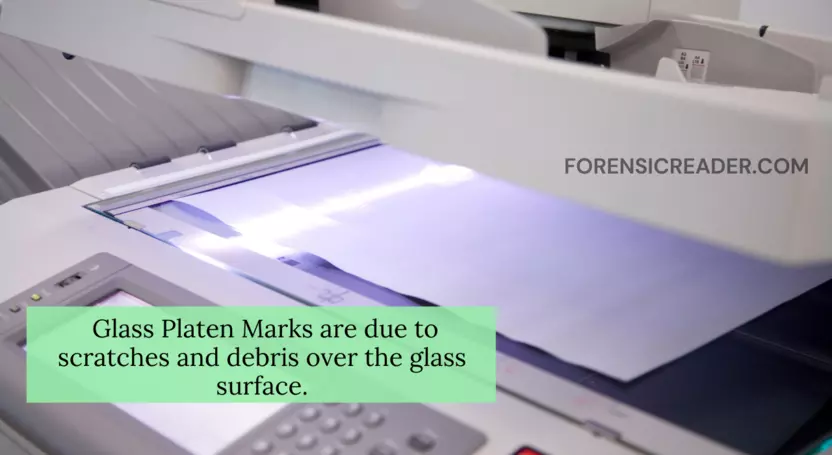
Glass Platen marks can be permanent or transitory. Permanent marks such as scratches to glass and transitory marks such as debris over the glass surface.
So, glass platen marks exclusively to the photocopier and scanned electronic-document that are later printed.
For instance, I have an inkjet printer and its copies and prints are nearly identical because it is new and I take good care of it.
Just kidding!!!
But, this is not true when using xerox machines in shops, schools, or college libraries due to excessive wear and tear on their glass platen.
Bottom Line: Glass Platen marks are exclusively seen in photocopied documents and scanned printed documents.
12. Back-Blanket Marking
White-sheet that holds the original document while photocopying can also be used to state whether the document is originally printed or photocopied.
These types of marking can be caused by misalignment of the original document or damage to the back blanket sheet as a result of prolonged use.
These markings are usually seen as:
- Noise at the edges of the sheet, or
- Maybe blackish lines at the edges, because of no closure
- Sometimes, loss of details in the corners and edges
These types of defects are not seen in printed documents.
Bottom line: Noise, blackening, and loss of corner details are the key features of copied documents that are lacking in printed form.
13. Imaging Lens Defects
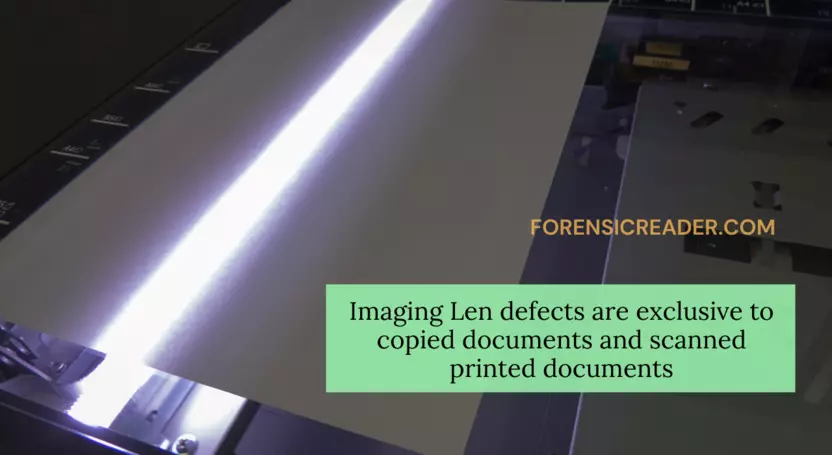
Photocopies use an imaging lens (Charge Coupled Device or Contact Image Sensor) that is used to replicate the exact image of the original sheet.
Damage to the imaging lens leads to marking over the copies. Most often, they are obstructed by dust and other adhesive debris, resulting in characteristic markings. These flaws, however, are uncommon.
Conversely, printed documents don’t need a photo lens for developing images. Therefore, markings due to imaging lenses are not seen in printed documents.
Bottom line: Very rare but exclusive to copied documents and scanned printed documents.
14. Toner Analysis
Chemical and instrumental analysis of toner can aid in distinguishing between printed and copied documents by determining their elemental and chemical compositions.
If FDE knows the ink type and composition of the original printed document, it can be used to differentiate the photocopied version.
Common toner analysis techniques are:
- SEM (Scanning Electron Microscope): for elemental analysis
- Pyrolysis Mass spectroscopy and IR spectroscopy: Identifying and comparing organic resigns of toners.
- UV or luminescent characteristics of their toners.
- TLC (Thin Layer Chromatography)
Bottom line: In a forensic examination of photocopied and printed documents, for the more explicit results, an FDE usually performs elemental analysis of toners.
Challenges While Dealing With Photocopied & Printed Documents
With the advancement of technology, there are various challenges a forensic examiner has faced while interpreting the difference between printed and copied documents. These are:
Challenge 1: Multiple Original Versions of the Same Document
If mail is sent to a different organization than the original electronic document. And different people printed electronic documents from different types of printers and then photocopied them.
In this case, a document examiner has numerous original reference samples to work upon that may/may not differ by class and individual characteristics.
Case 2: Multipurpose Printers
Multipurpose printers can be used as printers, copiers, scanners, and facsimile machines. So, the same machine can be used to print original documents or to make a copy of the documents.
This makes it hard for the examiner to differentiate between the inkjet/laser copy and the inkjet/laser print.
Case 3: Sequential-Switch Printing
Suppose, if document ‘A’ is first (1st generation) originally printed via laser printer and then copied using inkjet (2nd generation).
In this case, the microscopic examiner can state the difference between the original laser printed and copied inkjet printed.
But, what if that copied inkjet document (2nd gen) is laser xeroxed (3rd gen)?
In those cases, it characteristically appears to be an original laser copy of the inkjet document (2nd gen), not the laser (1st gen).
That’s why it’s harder to interpret.
Forget about the normal folks; it’s not even easier for a forensic document examiner.
Case 4: Machine-rendered Signatures and TrueType fonts
Nowadays, many high-end printing machines can identify the original signature from a document and convert it into a readable print form using TrueType fonts technology.
So, if one looks at the original document and machine-rendered printed signature documents, it looks different.
In these cases, your first instinct could be a ‘forged document’ or ‘a copied document’ even if it’s originally printed.
Therefore, a forensic document examiner must take this into account while dealing with TrueType fonts printed documents.
General FAQ
Is the document originally printed or a copy?
There are markers such as physical defects, transitory defects, marking due to glass platen, back blanket, and the imaging lens are very qualitative measures to define a photocopied document. These all defects are usually missing in printed documents.
Can you tell if a document has been printed?
Yes, it is possible. You can check for the marks of physical defects due to glass platen of scanner, staples marks, fold marks, black shades at corners due to non-closed back lid, and many more that are listed in the table. If all signs are missing, your document may be printed not photocopied.
What if two copies have the same defects?
It may or may not have originated from the same printer. This is due to the fact that it can be a copy of the copied document. Therefore, FDE should also consider this possibility.
What are the common machine defects seen in photocopied documents?
Transitory defects such as obstruction with debris, glass platen scratches, imaging lens defects, and image-sensitive drum defects are common machine defects seen in photocopied documents.
Read More:
- Identification of Paper Additives: Fillers, Oil, Waxes, and Pigment
- 21+ Forensic Questioned Document Instruments And Tools With Uses
- Can a Watermark on Paper be Forged? Prevention and Detection
- 14 Myths of Fingerprints And Questioned Documents: A Forensic Study

FR Author Group at ForensicReader is a team of Forensic experts and scholars having B.Sc, M.Sc, or Doctorate( Ph.D.) degrees in Forensic Science. We published on topics on fingerprints, questioned documents, forensic medicine, toxicology, physical evidence, and related case studies. Know More.
